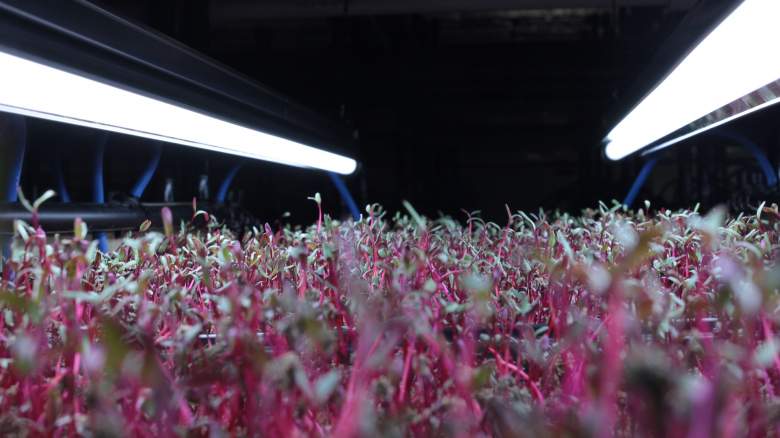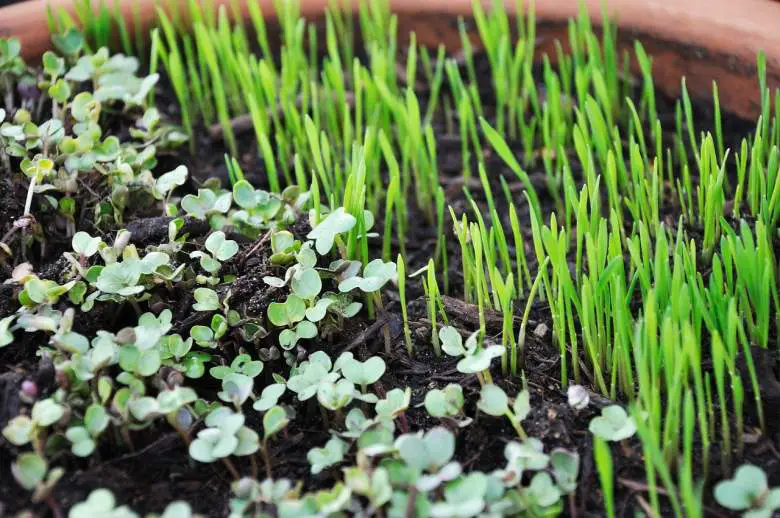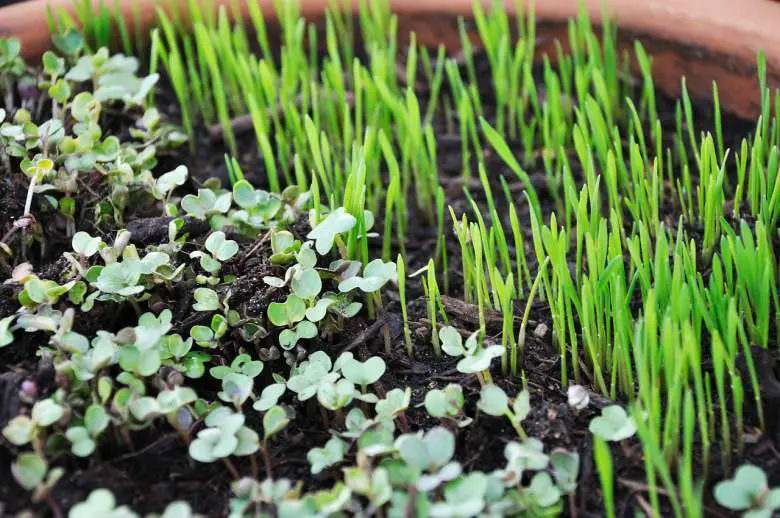Growing microgreens is not a small business. This burgeoning industry is gaining traction and putting down roots all around the world as casual gardeners along with commercial farmers are supplementing their income by going small.
But all in all, is it a profitable business to enter into? Are there customers willing and waiting to buy these micro vegetables and salads?
Fortunately, the barrier to entry is low, and the profit to be made is high, with potential customers from farmers’ markets to top-end restaurants ready and waiting to go micro.
The Business of Microgreens
A microgreen business is not necessarily a micro business. The investment required to start is very minimal, possibly as low as $100, and the investment in time can be measured in a couple of hours per day, depending on objectives.
The popularity of microgreens has reached a stage where demand is outstripping supply, where consumers are electing to purchase these vegetables over their larger relatives, confirming that if there was ever a time to enter into this lucrative field, it would be now.
Numerous restaurants relish the opportunity to garnish their dishes with these nutrient-dense greens and are more than willing to purchase these quality, organic, GMO-free products at a premium price.
With the right crop selection, marketing, and dedication, a small-scale operation with just 10 – 20 trays can make a healthy profit of between $500 – $1,000 a month. If that can be achieved on a part-time basis with minimal work, then imagine what could be achieved with a full-time operation.
A simple method to calculate what level of revenue can be attained is by cost analysis. That would start with the cost of such things as the trays, grow lights, growing mats, seeds selected, and even packaging. Factor in the time allocated and a ballpark figure can be reached to what the overheads would be.
Each tray should have the capacity to have three yields a month, and each yield should be about 10 oz. The market sale price is generally around $20 per tray, so with 10 trays, it’s possible to make $200 a month. Multiply that figure by the three yields from each tray and revenue of $600 a month is within reach.
Scaling up amounts to adding more trays and varying the seeds implanted to broaden the sales possibilities. From there, further expansion and increased revenue would be dependent on growing the customer base.
Also read: The Reasons Why Microgreens are Expensive
The Experts On Microgreens
Many experts attest to the sustainability of microgreens as the direction that farming has to take for the foreseeable future. They themselves have seen sales quadruple within a matter of months, acknowledging that it isn’t just a passing trend as more and more environmentally conscious consumers are eating wiser and healthier.
From the point of view of the casual farmer, a gap is being filled and buyers serviced on a more personal level than from a big corporation. That personalized attention is capturing an ever-increasing sector that is appreciating the quality of the greens on offer, a quality product that they can forward onto their ever more discerning clients.
The impact that microgreens are having is echoing through multiple sectors, from restaurants, to marketplaces, to personal chefs, to supermarkets, the wave of a revolution taking shape. A major factor is the ability to grow microgreens anywhere being an attractive lure for someone with green fingers who is confined within a concrete jungle.
This advantage of being able to grow microgreen vegetables and salads in even a small apartment indoors means that unpredictable weather conditions can be avoided. If run as a business rather than garnishing personal meal dishes, they can be located close to potential customers, making for easy deliveries and cutting down on the carbon footprint of having to truck the stock in.
Growing within this type of protective setting, opens wide the opportunity to grow a diverse range of agricultural microgreens that uses up to 95% less land than traditional outdoor farming.
The lack of experience is not a barrier to entry as this trade can be easy to learn, improve upon, and perfect, and the small amount of initial investment required makes this method appealing. It can be started from a single tray of seedlings on a windowsill, and a trial-and-error method can be employed for complete newbies with very little risk.
Experts predict that the acceptance of microgreens throughout so many sectors will continue to increase nationwide, with many more urban farmers importing the farm to the city, bringing fresh produce to those hard-to-reach inner-city zones, at affordable prices.
There are a plethora of blogs, books, and videos out there that can walk anyone through the start-up and growing phases, and how to overcome problems as well as how to repeat harvests profitably.
Even before the crops are harvested, however, the experts recommend contacting at least 25 – 30 local restaurants to sell to as well as scope out farmers’ markets and some supermarkets. And then beyond that have a regular routine to continue searching for buyers until a core group is purchasing what you’re growing regularly.
Another option is to sell directly to the consumer, either through Facebook or advertising. Whatever sales channel is selected, though, consistency is the key, to the quality of the product and to providing a good service to the growing client base.
A Microgreen Season
In the world of microgreens, growing seasons are not even a consideration. Couple that with the fact that within 1 to 4 weeks, depending on the crop chosen, a plant can be harvested, and seedlings replanted quickly, then it’s plain to see and appreciate the lure of growing salads and vegetables the micro way.
Due to this fast-growing period, the grower has more scope to experiment with the plants selected, either to eliminate them completely or have them under a rotation cycle to maximize sales. This quick turnaround time also allows scope for experimentation with different varieties rather than having to wait a full growing season to see if the results are a success or a dismal failure.
As in any business, some crops will have higher sales in some months than others, so it’s important to be able to swap out some crops quickly to take advantage of fluctuations and demand. If the interest in the quality of your produce increases dramatically, upscaling the microgreen farm is just a matter of adding a few more trays to satisfy the increased demand.
If maximizing the space available is a priority, experts recommend using racks to utilize unused vertical space. They are easy to install and this technique has enabled growers to boost their yields substantially, by properly organizing their crops, and many farmers have reaped the benefits of growing upwards.
Further methods of increasing the bottom line, according to experts in this field, can be augmented by taking note of the small details. For instance, can the yield be increased by adding a few more seeds to each tray? Can the overheads be reduced by cutting back on the light from the grow lamps to save on electricity costs?
A minor tweak here or there can make a big difference in any business, so it is advisable to keep records to understand where changes can be made, and new initiatives introduced.
There is also a temptation to grow as many varieties as possible to increase revenue opportunities, and there can be nothing wrong with that if there is already an established client base. However, keeping proper sales records can shine a light over a short period of time on which crops are selling well, and which need to face the cut.
The Best Microgreens To Grow
Essentially, the variety of microgreens that are selected can depend on the level of experience of the grower as some salads and vegetables are easier to start with than others, but may not command the highest resale prices.
If making a living is the goal or to supplement an income, then crop selection is important from the outset even though the time from seed to harvest is pretty fast.
Advice from expert microgreen farmers is to keep it simple. There is always a temptation to differentiate your business from the rest by planting obscure crops that will command higher sales prices but may not sell in sufficient quantities on a regular basis to provide a stable income.
Hard to grow and hard to sell, is never the way to go.
Choosing to start your microgreen farm with radishes, salads, sunflower seeds, or even pea shoots is the smart way to go as either of these three appeals to consumers, are easy to grow, and can be re-grown quickly to provide multiple harvests.
They offer a diverse variety of tastes, textures, and colors to dishes that appeal to chefs in particular. An added bonus is that they can be refrigerated after harvesting to extend the longevity of the product to keep them fresh if they cannot be sold immediately.
A rule of thumb is the wider the potential customer base due to the produce on offer, the better option of repeat sales, a regular income, and a profitable business.
As the business starts to grows more varied crops can be added and the growing space extended. Once this starts to happen additional attention to detail has to be increased in regards to crop health, maintaining the correct temperatures in the coolers, and ensuring there is sufficient light for optimum plant health.
Detrimental issues such as mold and pests can undo some of your hard work so it is important to periodically monitor these to avoid problems with the crops. Optimum health equals optimum quality and that will impact the demand for your microgreens.
Expert Tips For Your Microgreens
One of the best ways to advance your micro business is to listen to the experts. All of them have been where you are now and have learned the ropes by planting one seed at a time. Some of them have started on kitchen countertops and windowsills and grown from there.
Mistakes and missteps they have made along the way and the owner of Minifarm Box in La, Conor Fitzpatrick, has a few wise words to impart.
He first points out a southern facing windowsill where the sunlight naturally pours in can make the difference between a mediocre crop or a robust harvest packed with flavors and vibrant colors, not to mention the extended life cycle afforded.
He reiterates the importance of proper drainage so the plants do not become waterlogged, and that a lightweight soil seed starter mix is ideally used to start with as it won’t become too tightly packed around the growing roots. Ensure also that it is soaked sufficiently to start the seeds better on their sprouting journey.
Once harvested the microgreens can be cleaned in diluted apple cider vinegar and rinsed with water to remove any unwanted bacteria and seed husks.
The founder of The First Leaf Microgreens in India, Swati Jain, hails microgreens as a superfood as they are packed with antioxidants and healthy nutrients, as well as vitamins A, B, C, E and K. In fact, according to the United States Department of Agriculture, microgreens contain from four to 40 times more nutrients than the regular sized plants.
Regularly eating these nutrient-dense crops can reduce the risk of chronic diseases and improve heart health, especially if eaten in their raw natural state when the most amount of nutrients will be absorbed by the body to deliver maximum beneficial efficacy.
Broccoli microgreens, for example, have an anti-cancerous compound, sunflower microgreens are loaded with protein and fights the effects of aging in our cells, red amaranth microgreens maintain bone health, helps to control blood pressure, and even improves vision, and wheatgrass, juiced, and drank daily, purifies the liver and controls blood sugar levels.
Small they may be but microgreens pound for pound are a powerhouse of concentrated nutrients that are punching way above their weight class.
Is growing microgreens a profitable business? Ask the casual grower who is making over $2,000 a month from the windowsills in the comfort of their own home.





